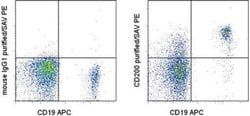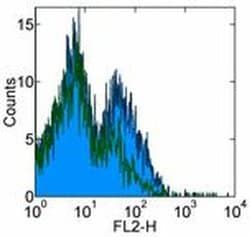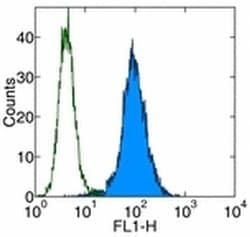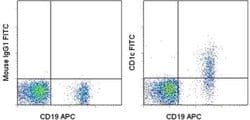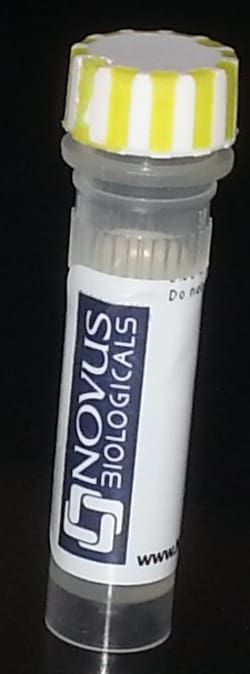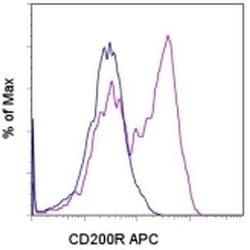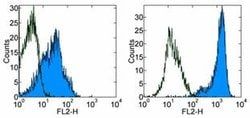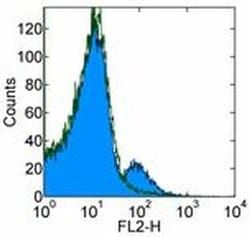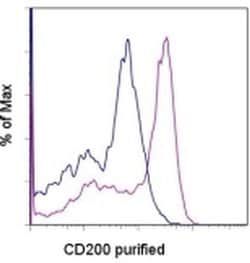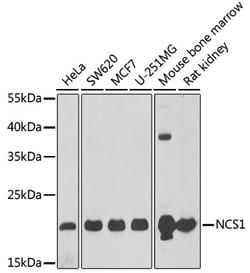50-130-84
CD200 Monoclonal Antibody (OX90), eBioscience™, Invitrogen™
Manufacturer: Invitrogen
Select a Size
| Pack Size | SKU | Availability | Price |
|---|---|---|---|
| Each of 1 | 50-130-84-Each-of-1 | In Stock | ₹ 10,947.00 |
50-130-84 - Each of 1
In Stock
Quantity
1
Base Price: ₹ 10,947.00
GST (18%): ₹ 1,970.46
Total Price: ₹ 12,917.46
Antigen
CD200
Classification
Monoclonal
Concentration
0.5 mg/mL
Formulation
PBS with 0.09% sodium azide; pH 7.2
Gene Accession No.
O54901
Gene Symbols
Cd200
Purification Method
Affinity chromatography
Regulatory Status
RUO
Gene ID (Entrez)
17470
Content And Storage
4° C
Form
Liquid
Applications
Flow Cytometry, Immunohistochemistry (Frozen), Immunohistochemistry (Paraffin)
Clone
OX90
Conjugate
Unconjugated
Gene
Cd200
Gene Alias
antigen identified by monoclonal antibody MRC OX-2; CD200; Cd200 antigen; Cd200 molecule; cell surface protein (thymocyte antigen identified by monoclonal antibody MRC-OX2); Cspmo2; hypothetical protein LOC534910; MOX1; MOX2; MRC; MRC OX-2 antigen; MRCOX2; My033; OX2; OX-2; OX-2 membrane glycoprotein
Host Species
Rat
Quantity
100 μg
Primary or Secondary
Primary
Target Species
Mouse
Product Type
Antibody
Isotype
IgG2a κ
Description
- Description: The monoclonal antibody OX90.1 recognizes mouse CD200 also known as OX2
- CD200 is a member of the Ig superfamily with 2 Ig domains, a transmembrane and cytoplasmic domain
- CD200 is expressed on resting and activated B cells, a subset of resting and activated T cells, keratinocytes, peripheral and central nerve cells, follicular dendritic cells and ovarian cells
- The interaction with CD200R results in macrophage activation (IL-6 production), inhibition of mast cell degranulation along with reduced TNF alpha and IL-13 secretion and overall attenuation of the activation status of lymphocytes
- Applications Reported: This OX90 antibody has been reported for use in flow cytometric analysis, immunohistology staining of frozen tissue sections, and immunohistology staining of paraffin embedded tissue sections
- Applications Tested: This OX90 antibody has been tested by flow cytometric analysis of mouse splenocytes
- This can be used at less than or equal to 0.5 μg per test
- A test is defined as the amount (μg) of antibody that will stain a cell sample in a final volume of 100 μL
- Cell number should be determined empirically but can range from 10^5 to 10^8 cells/test
- It is recommended that the antibody be carefully titrated for optimal performance in the assay of interest
- Purity: Greater than 90%, as determined by SDS-PAGE
- Aggregation: Less than 10%, as determined by HPLC
- Filtration: 0.2 μm post-manufacturing filtered
- CD200 is a type-1 membrane glycoprotein that contains two immunoglobulin domains, and belongs to the immunoglobulin superfamily
- CD200 is a broadly distributed cell surface glycoprotein that interacts with a receptor on myeloid cells (CD200R) and is implicated in locally preventing macrophage activation
- Distant, but recognizable, homologues of CD200 have been identified in many herpesviruses and poxviruses
- Studies of the related genes in mouse and rat suggest that CD200 may regulate myeloid cell activity and delivers an inhibitory signal for the macrophage lineage in diverse tissues
- Multiple alternatively spliced transcript variants that encode different isoforms of CD200 have been found
- Diseases associated with CD200 dysfunction include Mantle Cell Lymphoma and Primary Hypertrophic Osteoarthropathy.
Compare Similar Items
Show Difference
Antigen: CD200
Classification: Monoclonal
Concentration: 0.5 mg/mL
Formulation: PBS with 0.09% sodium azide; pH 7.2
Gene Accession No.: O54901
Gene Symbols: Cd200
Purification Method: Affinity chromatography
Regulatory Status: RUO
Gene ID (Entrez): 17470
Content And Storage: 4° C
Form: Liquid
Applications: Flow Cytometry, Immunohistochemistry (Frozen), Immunohistochemistry (Paraffin)
Clone: OX90
Conjugate: Unconjugated
Gene: Cd200
Gene Alias: antigen identified by monoclonal antibody MRC OX-2; CD200; Cd200 antigen; Cd200 molecule; cell surface protein (thymocyte antigen identified by monoclonal antibody MRC-OX2); Cspmo2; hypothetical protein LOC534910; MOX1; MOX2; MRC; MRC OX-2 antigen; MRCOX2; My033; OX2; OX-2; OX-2 membrane glycoprotein
Host Species: Rat
Quantity: 100 μg
Primary or Secondary: Primary
Target Species: Mouse
Product Type: Antibody
Isotype: IgG2a κ
Antigen:
CD200
Classification:
Monoclonal
Concentration:
0.5 mg/mL
Formulation:
PBS with 0.09% sodium azide; pH 7.2
Gene Accession No.:
O54901
Gene Symbols:
Cd200
Purification Method:
Affinity chromatography
Regulatory Status:
RUO
Gene ID (Entrez):
17470
Content And Storage:
4° C
Form:
Liquid
Applications:
Flow Cytometry, Immunohistochemistry (Frozen), Immunohistochemistry (Paraffin)
Clone:
OX90
Conjugate:
Unconjugated
Gene:
Cd200
Gene Alias:
antigen identified by monoclonal antibody MRC OX-2; CD200; Cd200 antigen; Cd200 molecule; cell surface protein (thymocyte antigen identified by monoclonal antibody MRC-OX2); Cspmo2; hypothetical protein LOC534910; MOX1; MOX2; MRC; MRC OX-2 antigen; MRCOX2; My033; OX2; OX-2; OX-2 membrane glycoprotein
Host Species:
Rat
Quantity:
100 μg
Primary or Secondary:
Primary
Target Species:
Mouse
Product Type:
Antibody
Isotype:
IgG2a κ
Antigen: __
Classification: __
Concentration: __
Formulation: __
Gene Accession No.: __
Gene Symbols: __
Purification Method: __
Regulatory Status: __
Gene ID (Entrez): __
Content And Storage: __
Form: __
Applications: __
Clone: __
Conjugate: __
Gene: __
Gene Alias: __
Host Species: __
Quantity: __
Primary or Secondary: __
Target Species: __
Product Type: __
Isotype: __
Antigen:
__
Classification:
__
Concentration:
__
Formulation:
__
Gene Accession No.:
__
Gene Symbols:
__
Purification Method:
__
Regulatory Status:
__
Gene ID (Entrez):
__
Content And Storage:
__
Form:
__
Applications:
__
Clone:
__
Conjugate:
__
Gene:
__
Gene Alias:
__
Host Species:
__
Quantity:
__
Primary or Secondary:
__
Target Species:
__
Product Type:
__
Isotype:
__
Antigen: Galectin 3
Classification: Monoclonal
Concentration: 0.5 mg/mL
Formulation: PBS with 0.09% sodium azide; pH 7.2
Gene Accession No.: P16110, P17931
Gene Symbols: LGALS3
Purification Method: Affinity chromatography
Regulatory Status: RUO
Gene ID (Entrez): 16854, 3958
Content And Storage: 4° C
Form: Liquid
Applications: ELISA, Flow Cytometry, Immunocytochemistry, Immunohistochemistry (Frozen), Immunohistochemistry (Paraffin), Immunoprecipitation, Western Blot
Clone: eBioM3/38 (M3/38)
Conjugate: Unconjugated
Gene: LGALS3
Gene Alias: 35 kDa lectin; advanced glycation end-product receptor 3; AGE-R3; beta-galactosides-binding lectin; carbohydrate-binding protein 35; CBP 35; CBP30; CBP-30; CBP35; epsilon BP; gal3; gal-3; galactose-specific lectin 3; Galactoside-binding protein; GALBP; galectin 3; Galectin3; galectin-3; GALIG; GBP; IgE binding protein; igE-binding protein; L-29; L31; L-31; L-34; L-34 galactoside-binding lectin; Laminin-binding protein; lectin galactoside-binding soluble 3; lectin galactoside-binding soluble 3 protein; lectin L-29; lectin, galactose binding, soluble 3; lectin, galactoside binding soluble 3; lectin, galactoside-binding, soluble, 3; lectin, galactoside-binding, soluble, 3 (galectin 3); LGALS2; Lgals3; MAC2; Mac-2; Mac-2 antigen
Host Species: Rat
Quantity: 100 μg
Primary or Secondary: Primary
Target Species: Human, Mouse
Product Type: Antibody
Isotype: IgG2a κ
Antigen:
Galectin 3
Classification:
Monoclonal
Concentration:
0.5 mg/mL
Formulation:
PBS with 0.09% sodium azide; pH 7.2
Gene Accession No.:
P16110, P17931
Gene Symbols:
LGALS3
Purification Method:
Affinity chromatography
Regulatory Status:
RUO
Gene ID (Entrez):
16854, 3958
Content And Storage:
4° C
Form:
Liquid
Applications:
ELISA, Flow Cytometry, Immunocytochemistry, Immunohistochemistry (Frozen), Immunohistochemistry (Paraffin), Immunoprecipitation, Western Blot
Clone:
eBioM3/38 (M3/38)
Conjugate:
Unconjugated
Gene:
LGALS3
Gene Alias:
35 kDa lectin; advanced glycation end-product receptor 3; AGE-R3; beta-galactosides-binding lectin; carbohydrate-binding protein 35; CBP 35; CBP30; CBP-30; CBP35; epsilon BP; gal3; gal-3; galactose-specific lectin 3; Galactoside-binding protein; GALBP; galectin 3; Galectin3; galectin-3; GALIG; GBP; IgE binding protein; igE-binding protein; L-29; L31; L-31; L-34; L-34 galactoside-binding lectin; Laminin-binding protein; lectin galactoside-binding soluble 3; lectin galactoside-binding soluble 3 protein; lectin L-29; lectin, galactose binding, soluble 3; lectin, galactoside binding soluble 3; lectin, galactoside-binding, soluble, 3; lectin, galactoside-binding, soluble, 3 (galectin 3); LGALS2; Lgals3; MAC2; Mac-2; Mac-2 antigen
Host Species:
Rat
Quantity:
100 μg
Primary or Secondary:
Primary
Target Species:
Human, Mouse
Product Type:
Antibody
Isotype:
IgG2a κ
Antigen: Galectin 3
Classification: Monoclonal
Concentration: 0.5 mg/mL
Formulation: PBS with 0.09% sodium azide; pH 7.2
Gene Accession No.: P16110, P17931
Gene Symbols: LGALS3
Purification Method: Affinity chromatography
Regulatory Status: RUO
Gene ID (Entrez): 16854, 3958
Content And Storage: 4° C
Form: Liquid
Applications: ELISA, Flow Cytometry, Immunocytochemistry, Immunohistochemistry (Frozen), Immunohistochemistry (Paraffin), Immunoprecipitation, Western Blot
Clone: eBioM3/38 (M3/38)
Conjugate: Unconjugated
Gene: LGALS3
Gene Alias: 35 kDa lectin; advanced glycation end-product receptor 3; AGE-R3; beta-galactosides-binding lectin; carbohydrate-binding protein 35; CBP 35; CBP30; CBP-30; CBP35; epsilon BP; gal3; gal-3; galactose-specific lectin 3; Galactoside-binding protein; GALBP; galectin 3; Galectin3; galectin-3; GALIG; GBP; IgE binding protein; igE-binding protein; L-29; L31; L-31; L-34; L-34 galactoside-binding lectin; Laminin-binding protein; lectin galactoside-binding soluble 3; lectin galactoside-binding soluble 3 protein; lectin L-29; lectin, galactose binding, soluble 3; lectin, galactoside binding soluble 3; lectin, galactoside-binding, soluble, 3; lectin, galactoside-binding, soluble, 3 (galectin 3); LGALS2; Lgals3; MAC2; Mac-2; Mac-2 antigen
Host Species: Rat
Quantity: 500 μg
Primary or Secondary: Primary
Target Species: Human, Mouse
Product Type: Antibody
Isotype: IgG2a κ
Antigen:
Galectin 3
Classification:
Monoclonal
Concentration:
0.5 mg/mL
Formulation:
PBS with 0.09% sodium azide; pH 7.2
Gene Accession No.:
P16110, P17931
Gene Symbols:
LGALS3
Purification Method:
Affinity chromatography
Regulatory Status:
RUO
Gene ID (Entrez):
16854, 3958
Content And Storage:
4° C
Form:
Liquid
Applications:
ELISA, Flow Cytometry, Immunocytochemistry, Immunohistochemistry (Frozen), Immunohistochemistry (Paraffin), Immunoprecipitation, Western Blot
Clone:
eBioM3/38 (M3/38)
Conjugate:
Unconjugated
Gene:
LGALS3
Gene Alias:
35 kDa lectin; advanced glycation end-product receptor 3; AGE-R3; beta-galactosides-binding lectin; carbohydrate-binding protein 35; CBP 35; CBP30; CBP-30; CBP35; epsilon BP; gal3; gal-3; galactose-specific lectin 3; Galactoside-binding protein; GALBP; galectin 3; Galectin3; galectin-3; GALIG; GBP; IgE binding protein; igE-binding protein; L-29; L31; L-31; L-34; L-34 galactoside-binding lectin; Laminin-binding protein; lectin galactoside-binding soluble 3; lectin galactoside-binding soluble 3 protein; lectin L-29; lectin, galactose binding, soluble 3; lectin, galactoside binding soluble 3; lectin, galactoside-binding, soluble, 3; lectin, galactoside-binding, soluble, 3 (galectin 3); LGALS2; Lgals3; MAC2; Mac-2; Mac-2 antigen
Host Species:
Rat
Quantity:
500 μg
Primary or Secondary:
Primary
Target Species:
Human, Mouse
Product Type:
Antibody
Isotype:
IgG2a κ
